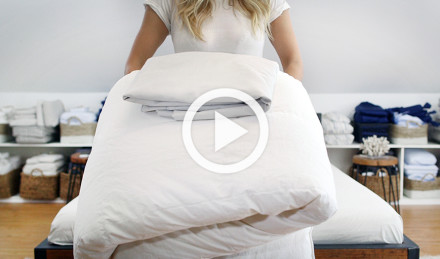One of the most luxurious parts of moving to a new home is setting up a new bathroom from scratch. Getting to buy new towels, a shower curtain matching your color scheme, a new bathroom mat and other essentials offers an exciting design experience.
If you’ve been in the same home for a while, you may be missing out on another important benefit of swapping out old bathroom essentials: hygiene and functionality.
While you might be tempted to wait to replace towels until they become threadbare or avoid ditching an older shower curtain liner until it gets too icky to salvage, you should replace many bathroom accessories much more regularly.
How Often Should You Replace Towels?
How Often Should You Replace Towels?
As a general rule, expect to replace towels about once per year. However, the actual lifespan of a towel can be much shorter or longer depending on the quality of the towels you buy, how often you wash them, and how you care for them. A towel can last anywhere from six months to three years.
If you’ve ever experienced a towel with lingering odors, reduced absorbency or fraying edges, you may think you should replace bath towels when they’re too embarrassing for guests to see. But that’s not a good rule of thumb. Towels lose their functionality and freshness long before you notice their quality decline.
For help deciding on which towels are best for your bathroom, explore the Best Towel Materials & Sizes guide.
Think Back to When Your Towels Were Brand New
A brand new towel soaks up water better, has a softer feel against your skin and dries quickly and more completely thanks to a more defined fabric texture. Ideally, your bath towels can maintain this level of comfort and usefulness for a few years.
Once towels have been used repeatedly, washed without proper care or never allowed to dry fully between uses, they lose their effectiveness and the only solution is to get a new towel set.
Prolong Your Towel’s Lifespan
So how long should a towel be used and how can you help your towels last longer?
The first step toward prolonging your towel’s lifespan is selecting a high-quality product. Towels are an investment for your bathroom, so try to choose a more functional and longer lasting product.
A brand new towel should be soft, lint-free and very absorbent. Thicker towels made with natural organic fibers offer superior moisture wicking, prolonged softness and extended durability.
Between uses, let your towel dry completely to help avoid bacteria growth and odors. Wash your towels every couple of days using an unscented, gentle detergent to avoid damaging the fabric. For more specific wash and care advice, read the How to Wash and Properly Care for Towels guide.
By investing in quality towels and paying attention to proper maintenance, you can help your bath towels last for a few years.
How Often Should You Replace Washcloths?
In general, expect to replace washcloths about every six to ten months. Washcloths are harder to maintain than towels because they get saturated with soap and water. Soaps designed for your body don’t necessarily play nice with some fabrics, so your washcloths may not last as long as your towels.
After each shower, make sure you’ve fully rinsed products out of your washcloth, squeeze out excess water and hang it up to dry. Avoid tossing a wet, balled-up washcloth in the laundry because it’s more likely to grow bacteria. Once your washcloth is dry, put it in the laundry and grab a fresh one for your next shower.
With proper maintenance, your washcloths can approach a similar lifespan to your other towels.
How Often Should You Replace a Shower Curtain?
How Often Should You Replace a Shower Curtain?
How often to replace a shower curtain depends on the type of curtain and its use. In general, expect to replace a shower curtain once a year, but the actual replacement time will vary depending on the type of liner you use, how many people live in your home, and how often you launder it.
Shower curtains and shower curtain liners are some of the easiest bathroom accessories to forget to replace or clean. After all, they come in contact with water and soap frequently, so shouldn’t they be self-cleaning and last a long time? Unfortunately, no.
Why Some Shower Curtains Don’t Last
The lifespan of your shower curtain depends on its material, the general humidity in your bathroom and how you leave your bathroom after your shower. Do you get out of a hot shower and rush to get ready for work or do you turn on the exhaust fan and spread the curtain out so it will dry better?
If you spend your time in more of a rush and don’t ensure your shower curtain dries out every day, then nasty issues like mildew and mold will spread and require you to replace your curtain much more frequently.
Fabric Shower Curtains Last Longer
Selecting a fabric shower curtain made of an easily washable material like linen or cotton will provide the longest lifespan possible. Schedule deep cleans for your bathroom a few times a year. Toss your fabric curtain in the laundry with some vinegar or bleach to kill mold and mildew spores. With proper care, you can get a few years of life from your fabric curtain.
If you prefer a plastic or vinyl shower curtain, proper maintenance like cleaning, drying and occasionally wiping it with a vinegar solution will help you get more time out of your shower curtain. However, you may need to replace your shower curtain every six months to a year.
For advice on everything to look for in a new shower curtain, explore the Guide to Shower Curtain Materials, Sizes, & Colors.
How Often Should You Replace a Shower Liner?
Shower curtain liners help protect your floors from water and your fabric shower curtain from mildew. PVC liners are priced to be considered disposable, but if you’re concerned about the environmental ramifications of chucking a liner in the trash every couple of months, you can choose a washable polyester curtain liner with a longer lifespan.
If you find yourself scrubbing away mildew that never seems to go away completely, it’s time to replace your shower liner.
When Your Bathrobe Loses Its Coziness
When Your Bathrobe Loses Its Coziness
Wrapping up in a cozy bathrobe provides an instant sense of relaxation and comfort, but even bathrobes have an expiration date.
Just like with towels, selecting a bathrobe made of a thick, absorbent material like Turkish cotton will deliver a more comfortable, longer-lasting experience. Make sure to follow the care instructions, use gentle detergent and wash it frequently to avoid bacteria growth and odors.
If you’re wearing your bathrobe over pajamas, you can easily keep the same bathrobe for five or more years with proper care. However, if you wear it straight out of the shower everyday, you’ll need to replace your bathrobe every two to three years or when you notice it’s becoming less effective.
Here’s some helpful resources for choosing a replacement bathrobe, read on:
Bathrobe Quiz: Find the Right Robe for You
The Coziest Bathrobes & Loungewear From Parachute
Best Organic Robes: What to Look for in a Sustainable Bathrobe
How Often Should You Replace a Bath Mat?
How Often Should You Replace a Bath Mat?
Expect to replace your bath mat about once a year. Your bath mat performs best when it’s freshly laundered. After multiple uses, weight and repeated saturation compress the fibers causing decreased absorbency. The best way to keep a bathmat effective longer is to clean it regularly and let it dry fully.
Trying to decide what kind of bath mat to get next? Explore the Bathroom Mat vs Bathroom Rugs guide for some meaningful advice.
Let Your Bath Mat Dry Completely
After showering, hang your bathroom mat or rug over the side of the tub or on a towel bar for better air circulation. Consider investing in two or more matching bath mats so you can wash them once a week or every other week and always have a fresh bath mat ready to go.
Rotating multiple bathmats between different parts of your bathroom also helps them last longer. As bath mats start to lose that plush feeling and absorbency, change your bath mat or rug’s location to the area in front of the sink or toilet. Even an older bathmat will keep your feet warm on cold tile floors!
If you take good care of your bath mat, you should only need to replace it about as often as you replace your towels.
Select Long Lasting Materials for Your Bathroom
Select Long Lasting Materials for Your Bathroom
Outfitting a bathroom from scratch can be an expensive proposition, but remember that investing in quality materials pays off in the long run.
If you try to save money by purchasing inexpensive towels or bath mats but you have to replace them twice or even three times as often, you haven’t actually saved any money. In fact, choosing lesser quality bathroom accessories also contributes to waste and larger potential problems in your bathroom.
As you shop for bathroom accessories like bath towels, bath mats or rugs, bathrobes and shower curtains, look for materials that are built to last.
Best Materials for Bathroom Essentials
Organic cotton and long-staple Turkish cotton provide a great balance of durability, softness and moisture wicking capabilities. For faster drying times in humid climates, consider the minimalist lightness and quick drying properties of a honeycomb woven Waffle Towel.
Whether you prefer a traditional plush style for your towels or something a bit more unique like a Mediterranean-inspired Fouta Stripe Towels, Parachute has the perfect option to suit your ideals.
Maintaining Your Bathroom Essentials
Enjoying a longer lifespan from your towels, bath mat and other accessories is simple once you develop a few beneficial habits.
Use the Fan
After your bath, turn on an exhaust fan or open a window. Vent as much of the steamy air as possible to help your bathroom essentials dry fully.
Don’t Use Hooks
Opt for towel bars instead of hooks for better air circulation and hang anything that’s wet, including your bath mat.
Shake off the Water
Shake excess water off your shower curtain and curtain liner. Once a week, wipe your shower curtain liner down with bathroom cleaner or a mild vinegar solution to avoid having to change your shower liner too frequently. Make sure to close your shower curtain so the full surface area has access to airflow.
Change Towels and Mats Regularly
Maintaining Your Bathroom Essentials
Enjoying a longer lifespan from your towels, bath mat and other accessories is simple once you develop a few beneficial habits.
Use the Fan
After your bath, turn on an exhaust fan or open a window. Vent as much of the steamy air as possible to help your bathroom essentials dry fully.
Don’t Use Hooks
Opt for towel bars instead of hooks for better air circulation and hang anything that’s wet, including your bath mat.
Shake off the Water
Shake excess water off your shower curtain and curtain liner. Once a week, wipe your shower curtain liner down with bathroom cleaner or a mild vinegar solution to avoid having to change your shower liner too frequently. Make sure to close your shower curtain so the full surface area has access to airflow.
Change Towels and Mats Regularly
Change bathroom towels a couple times each week for a fresh, cozy softness, straight out of the dryer.
Comfort That Lasts
When it comes to selecting essentials for your home that take comfort and longevity seriously, Parachute has plenty to offer. From thick, luxurious towels made of Turkish Cotton to durable, long lasting percale sheet sets crafted from long-staple cotton from Egypt, it’s easy to outfit a sustainable, environmentally conscious home.
Prioritize quality, comfort and style with an expansive range of great products for every room in your home.
For more bathroom and home decor advice, read on:
How to Turn Your Bathroom Into a Luxury Spa
Best Sustainable and Organic Bathroom Essentials
Best Organic Towels: What to Look For
Bathroom Interior Decorating Inspiration
Basket Decor Ideas for Around the House
How to Donate, Recycle, and Reuse Old Bed Sheets & Towels
How to Wash, Dry, and Care for Organic Cotton Towels and Sheets
Parachute Guide to Design & Decor Ideas Around the House
Eco-Friendly Home Essentials Needed for Sustainable Living
How to Fold and Style Towels Like a Luxury Hotel
Waffle Weave Fabric Guide: Cozy Waffle Home Essentials You Need
Bath Bath Guide: How to Best Bathe Your Newborn
Why Does a Newborn Need a Hooded Toddler Towel?
Comfort That Lasts
When it comes to selecting essentials for your home that take comfort and longevity seriously, Parachute has plenty to offer. From thick, luxurious towels made of Turkish Cotton to durable, long lasting percale sheet sets crafted from long-staple cotton from Egypt, it’s easy to outfit a sustainable, environmentally conscious home.
Prioritize quality, comfort and style with an expansive range of great products for every room in your home.
For more bathroom and home decor advice, read on:
How to Turn Your Bathroom Into a Luxury Spa
Best Sustainable and Organic Bathroom Essentials
Best Organic Towels: What to Look For
Bathroom Interior Decorating Inspiration
Basket Decor Ideas for Around the House
How to Donate, Recycle, and Reuse Old Bed Sheets & Towels
How to Wash, Dry, and Care for Organic Cotton Towels and Sheets
Parachute Guide to Design & Decor Ideas Around the House
Eco-Friendly Home Essentials Needed for Sustainable Living
How to Fold and Style Towels Like a Luxury Hotel
Waffle Weave Fabric Guide: Cozy Waffle Home Essentials You Need
Bath Bath Guide: How to Best Bathe Your Newborn
Why Does a Newborn Need a Hooded Toddler Towel?















